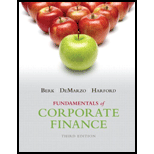
Short term borrowing: When company borrows for a period of fewer than twelve months, it is termed as long-term financing. For example short-term loan.
Long-term financing: When a company borrows for a period of more than twelve months it is termed as long-term financing. Long-term financing is in the form of long-term loan and debentures.
Permanent working capital: Permanent working capital is the minimum level of investment that a firm requires in working capital. To maintain continuous operations a firm should keep this minimum amount invested in its short-term assets.
Temporary working capital: Temporary working capital is the difference between a firm’s permanent working capital requirement and the firms actual level of investment in the short term.
To Determine: The amount and period of maximum short-term borrowing if, the company holds $400 cash in each quarter.
- If company assumes that long-term financing will be used for permanent working capital and short-term borrowing for temporary working capital then maximum short-term borrowing will happen when working capital is highest in third quarter at $1300 (working note)
- The difference between highest working capital and permanent working capital will be short-term borrowing. In the third quarter, permanent working capital is $700 (working note) so, $600
 will be short-term borrowing.
will be short-term borrowing. - The table below shows the period and amount of highest short-term borrowing.
Want to see the full answer?
Check out a sample textbook solution
Chapter 20 Solutions
Fundamentals of Corporate Finance (3rd Edition) (Pearson Series in Finance)
 Essentials Of InvestmentsFinanceISBN:9781260013924Author:Bodie, Zvi, Kane, Alex, MARCUS, Alan J.Publisher:Mcgraw-hill Education,
Essentials Of InvestmentsFinanceISBN:9781260013924Author:Bodie, Zvi, Kane, Alex, MARCUS, Alan J.Publisher:Mcgraw-hill Education,

 Foundations Of FinanceFinanceISBN:9780134897264Author:KEOWN, Arthur J., Martin, John D., PETTY, J. WilliamPublisher:Pearson,
Foundations Of FinanceFinanceISBN:9780134897264Author:KEOWN, Arthur J., Martin, John D., PETTY, J. WilliamPublisher:Pearson, Fundamentals of Financial Management (MindTap Cou...FinanceISBN:9781337395250Author:Eugene F. Brigham, Joel F. HoustonPublisher:Cengage Learning
Fundamentals of Financial Management (MindTap Cou...FinanceISBN:9781337395250Author:Eugene F. Brigham, Joel F. HoustonPublisher:Cengage Learning Corporate Finance (The Mcgraw-hill/Irwin Series i...FinanceISBN:9780077861759Author:Stephen A. Ross Franco Modigliani Professor of Financial Economics Professor, Randolph W Westerfield Robert R. Dockson Deans Chair in Bus. Admin., Jeffrey Jaffe, Bradford D Jordan ProfessorPublisher:McGraw-Hill Education
Corporate Finance (The Mcgraw-hill/Irwin Series i...FinanceISBN:9780077861759Author:Stephen A. Ross Franco Modigliani Professor of Financial Economics Professor, Randolph W Westerfield Robert R. Dockson Deans Chair in Bus. Admin., Jeffrey Jaffe, Bradford D Jordan ProfessorPublisher:McGraw-Hill Education





